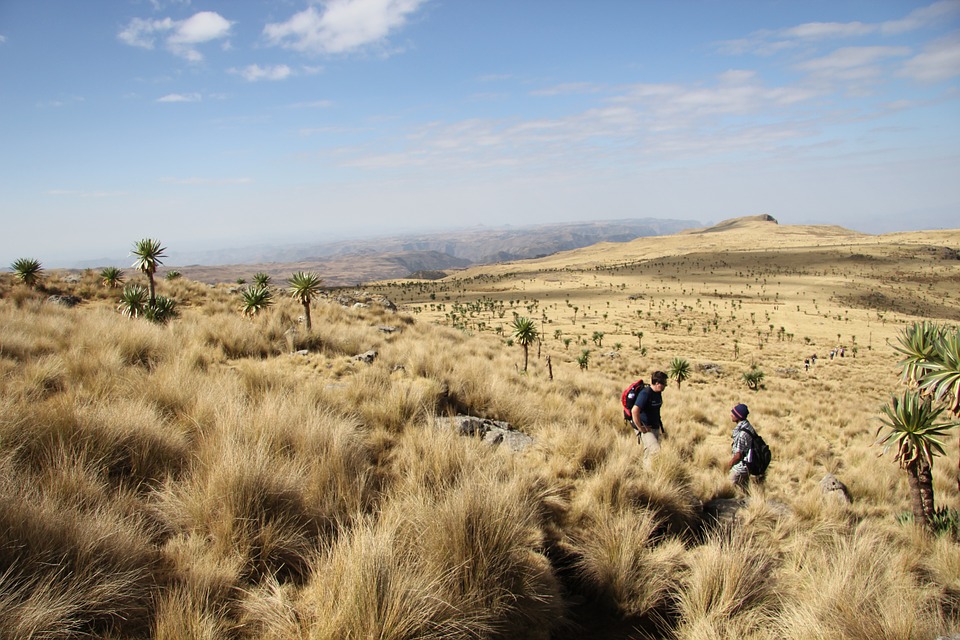The Simien Mountains National Park’s (SMNP) name is traditionally linked to the Amharic word “Semien” which means north. It is one of the best of national parks in terms of scenic potential & variety. High rising volcanic plugs that are a result of a vast series of volcanic activities in the past are the main and major attractions of the park.
The SMNP, after being recommended by the UNESCO mission in 1965, was formally established by 1966 and gazetted in 1966. Due to its unique landscape and the rich biodiversity resources, the park was listed on the list of World Natural Heritage by UNESCO in 1978.
It is part of the area of wonderful topographical features known as “the roof of Africa”. It includes opportunities for viewing a variety of wildlife, birdlife, and flora. The unchanging traditional life of the local people, trekking, mountain hiking and ecological studies gives SMNP its excellent potential as the first important place of interest to visit in the Ethiopian tourist circle.
Species recorded: 21 mammals and 180 birds
Charismatic species: Walia Ibex
Location: The Simien Mountains National Park is found North West of the country, in the Amhara Regional State, about 850km from Addis Ababa and about 102km from Gondar. It has an area of about 232.5km2 and is adjacent to Mt. Ras Dashen, which is the tenth highest peak in Africa. It lies within the center of a triangle that forms part of the important historical sites of Ethiopia which are regularly visited by a number of foreign tourists namely. This triangle includs Axum, Gondar and Lalibela.
Rainy Season: The rainy season in the area occurs between June and mid- September. Average annual rainfall is about 1550mm.
Temperature: The area usually experiences a cool climate, which ranges from -2.5 to 18 degrees. During the dry season early mornings are the coldest time of the day.
The SMNP, after being recommended by the UNESCO mission in 1965, was formally established by 1966 and gazetted in 1966. Due to its unique landscape and the rich biodiversity resources, the park was listed on the list of World Natural Heritage by UNESCO in 1978.
It is part of the area of wonderful topographical features known as “the roof of Africa”. It includes opportunities for viewing a variety of wildlife, birdlife, and flora. The unchanging traditional life of the local people, trekking, mountain hiking and ecological studies gives SMNP its excellent potential as the first important place of interest to visit in the Ethiopian tourist circle.
Species recorded: 21 mammals and 180 birds
Charismatic species: Walia Ibex
Location: The Simien Mountains National Park is found North West of the country, in the Amhara Regional State, about 850km from Addis Ababa and about 102km from Gondar. It has an area of about 232.5km2 and is adjacent to Mt. Ras Dashen, which is the tenth highest peak in Africa. It lies within the center of a triangle that forms part of the important historical sites of Ethiopia which are regularly visited by a number of foreign tourists namely. This triangle includs Axum, Gondar and Lalibela.
Rainy Season: The rainy season in the area occurs between June and mid- September. Average annual rainfall is about 1550mm.
Temperature: The area usually experiences a cool climate, which ranges from -2.5 to 18 degrees. During the dry season early mornings are the coldest time of the day.

Ecological zone: North-west highlands.
Vegetation types: Afro-alpine steppe belt (grassland zone), Ericaceous belt and Afro-montane forest belt.
Major wildlife species: The park is endowed with an array of animal biodiversity which represents species of both African and Eurasian origins. The Walia ibex (Capra Walie) is one of the most fascinating wild goats, endemic to the area. Though, the rare Ethiopian wolf (Canis Simensis) is also another tourist attraction of the park.
Tourists will have ample opportunities to learn about the primates by looking at socio-ecological aspects of the endemic Gelada Baboon (Theropithecus gelada), bleeding heart baboon or lion monkey, as it is some times called. Maternal care, hierarchy among males, fighting for takeover and dominance among them, are examples of impressive behaviors of this animal.
There are also various species of larger animals such as leopard, caracal, wildcat, common jackal, hyena, bushbucks(common bushbuck & an endemic subspecies called Menelik’s bushbuck), klipspringer, bush dicker, black and white Colobus monkey, Anubis and Hamedryads baboons. Moreover, there is a considerable number of species of rodents which are also conspicuous in different habitats of the park.
The Simien Mountains National Park also boast a unique flora. Alpine steppe is characterized by the occurrence of a diverse range of habitats and altitudinal gradients. The natural vegetation found in the Afromontane areas (altitudes between 2000-2700 meters) include species like Hagenis abyassinica, Dombeya torride, Scheffiera abyssinica, Olea europea, Juniperus procera, Albiza shimperians, and many others. The afromontane forest plant species such as Hebenstreitia dentate, Scabiosa columbaria, Swertia spp. Saturia simensis, Saxifraga hederifolia and many others are most commonly observed by visitors to the area. There is dominated forest which includes the Ericaceous belt (tree heather or Erica arborea), dotted with St. John’s wort (Hypericum revoltum), both of which are known as Forbes and small shrubs in other parts of the world.
In higher altitudes above 3200m the Afro alpine vegetation dominates the region. Here grass and herbaceous species are the dominant flora, the most notable species is the Giant Lobella (Lobelia rynchopetalum). Other species of interest include Heliichrysum citrispinu, Kniphofilia, Alchemilla species, as Rosularia simensis, etc. Sacculent plants such as Rosularia simensis, Arabis thaliana, Primula verticulate, are common in steep, inaccessible cliffs of rocky parts. Different species of grasses such as Festuca gelbertiana and Carex monostachya are common and dominant in areas of the high plateau. The numerous flowers in the upland and forested areas of the Simien Mountains National Park are of photographers delight.
Endemic mammals of the park: Gelada Baboon, Walia Ibex, Ethiopian Wolf, Mahomet’s Mouse, White-footed Rat, Ethiopian grass Rat, Crocidura baieyi Lovat’s White-tailed Rat, Grey-tailed Rat, Giant Molerat and Simen Mouse.
Common birds of the park: The park is listed as one of the important Bird Areas in Ethiopia. Over 180 species of birds are recorded in the park and few of them are endemic to the country. The SMNP is a bird watchers paradise; some of the birds that are frequently viewed are the Lammergeyer (bearded vulture), Augur buzzard, Verreaux’s eagle, Erckel’s francolin, Alpine chat, Ankober siren, the Vultures, Tacazze sunbird, etc. Tourists interested in bird watching are expected to trek in the lowlands and should have ample days to spend.
Endemic birds of the park: Abyssinian cat bird, Abyssinian longclaw, Spot-breasted plover and Black-headed siskin
Major physical/geological features: Spectacular mountain scenery and escarpments consist of dark Trapp basalts and bright, soft tuff.
Vegetation types: Afro-alpine steppe belt (grassland zone), Ericaceous belt and Afro-montane forest belt.
Major wildlife species: The park is endowed with an array of animal biodiversity which represents species of both African and Eurasian origins. The Walia ibex (Capra Walie) is one of the most fascinating wild goats, endemic to the area. Though, the rare Ethiopian wolf (Canis Simensis) is also another tourist attraction of the park.
Tourists will have ample opportunities to learn about the primates by looking at socio-ecological aspects of the endemic Gelada Baboon (Theropithecus gelada), bleeding heart baboon or lion monkey, as it is some times called. Maternal care, hierarchy among males, fighting for takeover and dominance among them, are examples of impressive behaviors of this animal.
There are also various species of larger animals such as leopard, caracal, wildcat, common jackal, hyena, bushbucks(common bushbuck & an endemic subspecies called Menelik’s bushbuck), klipspringer, bush dicker, black and white Colobus monkey, Anubis and Hamedryads baboons. Moreover, there is a considerable number of species of rodents which are also conspicuous in different habitats of the park.
The Simien Mountains National Park also boast a unique flora. Alpine steppe is characterized by the occurrence of a diverse range of habitats and altitudinal gradients. The natural vegetation found in the Afromontane areas (altitudes between 2000-2700 meters) include species like Hagenis abyassinica, Dombeya torride, Scheffiera abyssinica, Olea europea, Juniperus procera, Albiza shimperians, and many others. The afromontane forest plant species such as Hebenstreitia dentate, Scabiosa columbaria, Swertia spp. Saturia simensis, Saxifraga hederifolia and many others are most commonly observed by visitors to the area. There is dominated forest which includes the Ericaceous belt (tree heather or Erica arborea), dotted with St. John’s wort (Hypericum revoltum), both of which are known as Forbes and small shrubs in other parts of the world.
In higher altitudes above 3200m the Afro alpine vegetation dominates the region. Here grass and herbaceous species are the dominant flora, the most notable species is the Giant Lobella (Lobelia rynchopetalum). Other species of interest include Heliichrysum citrispinu, Kniphofilia, Alchemilla species, as Rosularia simensis, etc. Sacculent plants such as Rosularia simensis, Arabis thaliana, Primula verticulate, are common in steep, inaccessible cliffs of rocky parts. Different species of grasses such as Festuca gelbertiana and Carex monostachya are common and dominant in areas of the high plateau. The numerous flowers in the upland and forested areas of the Simien Mountains National Park are of photographers delight.
Endemic mammals of the park: Gelada Baboon, Walia Ibex, Ethiopian Wolf, Mahomet’s Mouse, White-footed Rat, Ethiopian grass Rat, Crocidura baieyi Lovat’s White-tailed Rat, Grey-tailed Rat, Giant Molerat and Simen Mouse.
Common birds of the park: The park is listed as one of the important Bird Areas in Ethiopia. Over 180 species of birds are recorded in the park and few of them are endemic to the country. The SMNP is a bird watchers paradise; some of the birds that are frequently viewed are the Lammergeyer (bearded vulture), Augur buzzard, Verreaux’s eagle, Erckel’s francolin, Alpine chat, Ankober siren, the Vultures, Tacazze sunbird, etc. Tourists interested in bird watching are expected to trek in the lowlands and should have ample days to spend.
Endemic birds of the park: Abyssinian cat bird, Abyssinian longclaw, Spot-breasted plover and Black-headed siskin
Major physical/geological features: Spectacular mountain scenery and escarpments consist of dark Trapp basalts and bright, soft tuff.

Tours: The main attraction of the, Simen Mountains National Park is its biosphere such as steep cliffs, escarpments, landscape, cool climate and endemic wildlife. These spectacular attractions can be largely discovered through trekking. So trekking is one of the main reasons to visit the park.
THE TREKKING ROUTES:
From Debark to Sankaber camp: It would normally last 3-4 days, Tiya Afaf is the spectacular observation point on this route. From this point the Gelada Baboon can be seen. The camp is equipped with a modest infrastructure and a tourist lodge.
From Sankaber camp through Gich camp to Chennek camp: It would normally take 6 days, the viewpoints include:
- Nigus Aysimush: one of a spectacular observation points offers good opportunity to view wildlife, including Walia Ibex
- Jinbar Waterfall: gives a fantastic view of an impressive river waterfall
- Gidir Got Summit: offers the most spectacular views of the escarpments including an ibex.
- Seha Summit: offersthe most beautiful views of the escarpments including an ibex
- Imet Gogo Summit: offers a good opportunity to see Walia Ibex, Gelada Baboons and has spectacular views in all directions.
- Kurbet Metaya: offers a good opportunity to view Walia Ibex
Chennek camp to Ras Dashen (the highest summit in Ethioipia) It takes at least 9-10 days.
Experiences to enjoy outside the park: Tourist can enjoy nature tourism, the northern part is famous for amazing tourist historical routes, such as Lalibella, Gondar and Axum.










